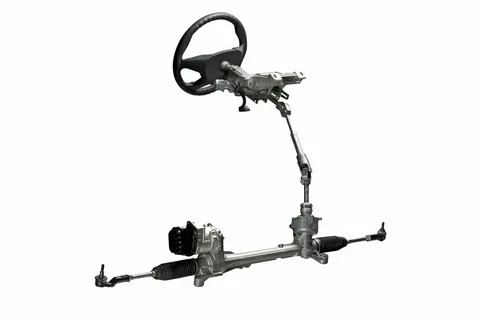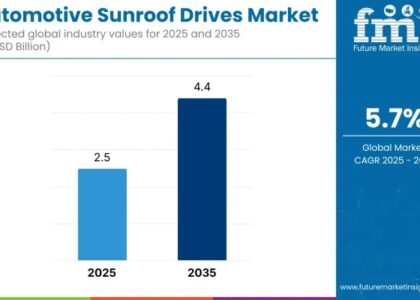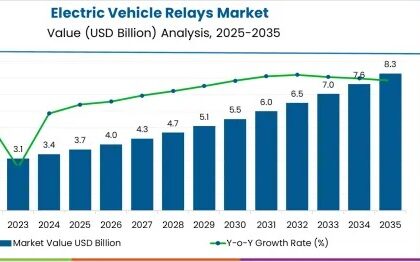The global electronic power steering (EPS) market is projected to reach USD 29,378.8 million in 2025 and expand to USD 48,774.3 million by 2035, registering a CAGR of 5.2% over the forecast period. In 2024, year-on-year growth of 4.7% was recorded, driven by the rising adoption of steer-by-wire systems, electric vehicle architecture, and the integration of driver-assistance features.
As vehicles evolve from analog machines to software-defined systems, every component is being reimagined for precision, efficiency, and intelligence. Nowhere is this transformation more evident than in the steering column. Once powered by hydraulic pressure and mechanical linkages, steering is now increasingly guided by a smarter, quieter force—Electronic Power Steering (EPS).
It doesn’t drip fluid or draw much attention under the hood, but EPS is rapidly becoming the steering backbone of modern mobility. By replacing hydraulics with electronic actuators and sensors, EPS systems deliver the responsiveness today’s drivers demand—while laying the groundwork for autonomous vehicles tomorrow.
Get Ahead with Our Report: Request Your Sample Now!
https://www.futuremarketinsights.com/reports/sample/rep-gb-1962
Beyond Hydraulics: Precision with Purpose
Traditional hydraulic systems were powerful but inefficient—constantly running even when not needed. EPS, in contrast, operates only when input is detected, optimizing energy use while enhancing control. Through embedded sensors and electric motors, EPS systems respond dynamically to driving conditions, vehicle speed, and steering angles.
This translates into more than just lighter steering. It enables variable assist levels, smoother handling, and fine-tuned feedback—creating a driving experience that feels tailored, intuitive, and adaptable in real time.
Overshadowed by Autonomy, Enabling the Shift
While headlines focus on self-driving cars and AI copilots, the ability to control a vehicle’s steering electronically is a non-negotiable foundation for automation. EPS is the enabling hardware that allows advanced driver assistance systems (ADAS) and autonomous platforms to function safely.
Lane keeping, auto-parking, highway piloting—all depend on steer-by-wire control facilitated by EPS. As such, it’s not just a comfort upgrade—it’s a strategic technology steering the industry toward full autonomy.

Efficiency Meets Intelligence
One of the key advantages of EPS is its efficiency. By eliminating pumps, belts, and hydraulic fluids, it reduces both weight and mechanical drag, improving fuel economy and simplifying vehicle architecture. But the real power lies in its intelligence.
EPS systems are now integrated with vehicle networks, receiving and sending data to central control units. This allows for predictive adjustments based on road conditions, driver behavior, and even real-time diagnostics. In electric and hybrid vehicles, this efficiency becomes even more critical, helping to maximize battery range without compromising drivability.
Design Flexibility for a New Era of Mobility
EPS also introduces a new level of design flexibility. Without the spatial constraints of hydraulic lines and bulky reservoirs, automakers can rethink vehicle layouts and steering systems. Modular EPS platforms support a variety of vehicle sizes—from compact city cars to commercial trucks—scaling easily across product lines.
For emerging mobility solutions such as autonomous pods, shared shuttles, or steer-by-wire concepts, EPS becomes more than a steering system—it becomes a modular control interface ready to integrate with next-gen architectures.
Exhaustive Market Report: A Complete Study
https://www.futuremarketinsights.com/reports/electronic-power-steering-market
Safety in Silence
EPS doesn’t just react; it learns. Adaptive algorithms can detect and correct oversteer or understeer in milliseconds. Some systems offer torque feedback that enhances road feel while improving vehicle stability. Others incorporate fail-safe modes and redundancy, making them compliant with the rigorous safety standards required for automated driving.
Combined with sensors, cameras, and AI, EPS is helping vehicles not only respond to the driver—but anticipate and prevent potential hazards on the road.
The Unseen Force Behind Smarter Mobility
Drivers may never notice their EPS system at work. There’s no sound, no fluid hiss, no tactile reminder—just seamless, responsive control. But beneath that silence lies a transformative force that’s reshaping how vehicles move, react, and think.
Ignore EPS, and you’re left steering with yesterday’s tools. Embrace it, and you open the road to intelligent handling, improved safety, and autonomy-ready design. In the age of smart mobility, steering is no longer just a function—it’s a system of intelligence. And EPS is at the wheel.





